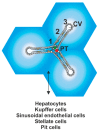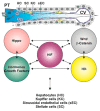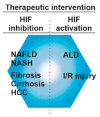Liver Zonation in Health and Disease: Hypoxia and Hypoxia-Inducible Transcription Factors as Concert Masters
- PMID: 31083568
- PMCID: PMC6540308
- DOI: 10.3390/ijms20092347
Liver Zonation in Health and Disease: Hypoxia and Hypoxia-Inducible Transcription Factors as Concert Masters
Abstract
The liver and its zonation contribute to whole body homeostasis. Acute and chronic, not always liver, diseases impair proper metabolic zonation. Various underlying pathways, such as β-catenin, hedgehog signaling, and the Hippo pathway, along with the physiologically occurring oxygen gradient, appear to be contributors. Interestingly, hypoxia and hypoxia-inducible transcription factors can orchestrate those pathways. In the current review, we connect novel findings of liver zonation in health and disease and provide a view about the dynamic interplay between these different pathways and cell-types to drive liver zonation and systemic homeostasis.
Keywords: HIF; Hepatocytes; ROS; antioxidants; antioxidative enzymes; diet; fibrosis; homeostasis; hypoxia; liver; matrix; metabolic zonation; metabolism; morphogen signaling; optimization; pathology; regulatory network; sinusoid.
Conflict of interest statement
The author declares no conflict of interest.
Figures



References
Publication types
MeSH terms
Substances
Grants and funding
LinkOut - more resources
Full Text Sources
Medical

